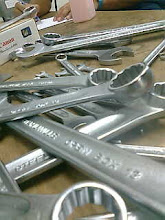1940 Triumph Tiger 100
Evolving the original Speed Twin

Say you’re legendary Triumph engine designer Edward Turner. And let’s say you’ve just produced the landmark 1938 Speed Twin—a motorcycle that proved two cylinders can be as practical as one and as fast as four.

What do you do for an encore? Easy: You design this machine a year later and prove that twins can do everything better. Thus was born the Tiger 100—named for its alleged top speed, not its displacement. It was a lighter, more powerful twin designed for performance enthusiasts.
Several changes fueled the evolution. One of the most important upgrades was the use of forged alloy pistons, a very early use of such technology. Another was the rigid cylinders, forged in a single casting and held in place by eight studs, instead of the Speed Twin’s six. Like the Speed Twin, the Tiger 100 used gears instead of a chain to drive the camshaft, and both cylinders were fed by a single Amal carburetor, which was possible thanks to the 360-degree firing interval of the two cylinders. Triumph didn’t scrimp on the styling either.
Attention to detail resulted in a stunning machine. The chrome-plated, down-swept exhaust pipes framed the polished crankcase beautifully. And the chrome finish on the enlarged, 4-gallon gas tank was complemented by silver fenders with tasteful black pinstriping. In its day, the bike was remarkably capable on the track, which made it easy for racers to set several marks, including Freddie Clarke’s 1939 lap record at Brooklands of 118.02 mph on a bored-out 503cc Tiger 100.
With World War II on the horizon, though, such pursuits were short-lived, as Triumph turned its attention to war production by the early 1940s. In fact, this 1940 Tiger 100, donated to the Motorcycle Hall of Fame Museum by Benny T. Bootle, was one of the last bikes to come out of the Triumph factory before it was demolished in the bombing of Coventry in World War II. Turner’s vertical twin was revived after the war, though, and went on to become one of motorcycling’s truest classics, enduring and thriving for nearly half a century—until the last Bonneville twin rolled off the line in 1988. The historic name was revived by the new Triumph in 2001.






0 comments:
Post a Comment